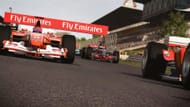Codemasters' F1 franchise is at the forefront of the motorsport video game market and has had a new release every year since 2009. A total of 16 titles have been released so far across multiple platforms, all focusing on the world's premier motorsport. Though many of these entries have been well-received, some have garnered criticism and divided the community's opinions.
With that in mind, here's our ranking of every Codemasters F1 game ever released.
Note: This ranking is subjective and solely reflects the author's views.
Looking for Crossword hints & solutions? Check out latest NYT Mini Crossword Answers, LA Times Crossword Answers, and Atlantic Crossword Answers
The 16 Codemasters F1 games, ranked from worst to best
16) F1 2015

The first F1 title on the eighth generation of consoles (PS4 and Xbox One) was poorly received. Though the in-house EGO engine was updated to enhance graphical fidelity and enhance physics, the game was simply too buggy for its own good.
While it included all the tracks and drivers from the 2014 season, F1 2015 felt rushed and incomplete. The absence of a player career mode and Safety Cars, along with persistent bugs that remain unpatched, contributed to its unfinished feel.
15) F1 24

Surprisingly low on this list is F1 24, the latest entry in the franchise. One of the biggest complaints about it is that it shows minimal evolution from previous titles, yet it’s priced as a full release. Utilizing the same engine as F1 2015, the game carries over certain bugs that have lingered since 2015.
However, the most significant complaint about F1 24 is the poorly optimized handling model at launch, which allowed players to take corners like Turn 1 at Qatar flat out, with the car gripping unrealistically. The game continues to suffer from major issues months after its release. The only positive aspect is that the franchise can only improve from here.
14) F1 22

The 2022 season introduced F1’s ground effect era, along with a new game that unfortunately faced severe handling and AI issues.
F1 22 received a mixed response. The traction and handling models were lacking, and numerous bugs plagued its lifecycle. Additionally, the popular Braking Point storyline was replaced with Super Cars, which were confined to time trial mode. The introduction of F1 Life mode, with its virtual sofas and light fixtures, was also widely criticized.
13) F1 2009

F1 2009 marked Codemasters' first attempt at an F1 title. The game was developed by Sumo Digital for the Nintendo Wii and PSP.
Considering the technological limitations of the hardware, F1 2009's shortcomings in the graphics department are understandable. The game features the entire 2009 season, including all tracks and drivers. However, having to steer with the Wii remote's motion sensors and the absence of a damage model make it a unique yet largely forgotten entry in the series.
12) F1 2014

While the early 2010s were strong for the F1 franchise, F1 2014 represented a step backward. Building on the foundation of F1 2013, the title felt more like a reskin than a true sequel.
With only track and driver updates, the game omitted the classic content from its predecessor and failed to introduce anything new. Additionally, the regulation shift from V8 to quieter V6 turbo-hybrid engines led to some criticism.
Overall, F1 2014 is a solid, albeit content-light, game. It was also the last title to be released on the seventh generation of consoles: the PS3 and Xbox 360.
11) F1 2011

The 2011 F1 season was notable for introducing the DRS and KERS systems, both now staples of the sport. The game that year faithfully represented the season, featuring all 24 drivers and 19 tracks, including India’s Buddh International Circuit.
However, the opponent AI sometimes leaned more toward "artificial" than "intelligent." Handling, particularly with non-steering wheel devices, also felt somewhat sluggish. Having said that, the game remains decent and has some replay value.
10) F1 2018

F1 2018 aimed to refine every aspect of its predecessors, launching on the PS4, PC, and Xbox One. It introduced the ERS battery system that became a standard feature in Formula 1 games.
While its graphical quality doesn't quite match that of its successors or even some predecessors, it offers a variety of classic cars and an engaging single-player career mode.
9) F1 2016

Building off the troubled launch of F1 2015, the 2016 installment of the franchise had a lot riding on its shoulders and largely delivered. It significantly improved on its predecessor in many areas, despite some lingering glitches.
F1 2016 brought back the driver career mode and introduced an R&D system that allowed players to upgrade their cars and enhance performance. Subjectively, its visuals hold up well, even in 2024.
8) F1 2019

In many ways, F1 2019 can be seen as F1 2018 v2.0, enhancing nearly every aspect of its predecessor. The game boasts polished graphics and improved performance while featuring all the drivers and tracks from the real-life season. Notably, it was the first title to feature F1's popular feeder series, Formula 2, with rosters from both 2018 and 2019 available for players.
F1 2019 also introduced a story mode, featuring fictional drivers Lukas Weber and Devon Butler, who progress alongside the player. Additionally, the game marked the last appearance of classic F1 cars from the 1970s and 1980s. It also introduced driver transfers between teams.
7) F1 2012

The 2012 F1 game is highly regarded among fans for good reason. It built upon F1 2011, adding a new “Champions Mode” where players could compete against the seven world champions of that year in various challenges. However, it lacked a custom single race weekend option and fell short in career mode immersion compared to its predecessors.
Notably, this was the first Codemasters title to feature a "Young Drivers' Test," which assessed player skills and unlocked teams in Career Mode based on performance.
6) F1 2021

Following the success of F1 2020, F1 2021 had a mixed initial reception, but Codemasters worked to address many bugs over time, resulting in a much-improved experience by the end of its lifecycle.
This game also marked the last release before EA took over for 2022. It featured the story mode first introduced in F1 2019, this time placing players in the role of young talent Aiden Jackson. However, it notably excluded classic cars that had been featured in earlier titles.
New circuits, such as Imola and Portimao, were included, but Istanbul Park and Qatar, which were part of the real-life calendar, were absent.
5) F1 23

F1 23 distinguished itself from F1 22 with a revamped handling model and improved physics, making it the game that fans had hoped the latter would be.
The Braking Point story mode returned, once again with Aiden Jackson as the main protagonist. The new Las Vegas circuit and the Lusail Circuit in Qatar featured prominently in the gameplay.
4) F1 2017

Building on the solid foundation of F1 2016, the 2017 game introduced numerous classic cars and enhanced the driver career mode. Players could participate in optional invitational events featuring classic car challenges.
This installment was the last to include Malaysia's Sepang circuit and the first to allow racing at midnight in Monaco. It also offered a Championship mode where players could select different scenarios and rules, competing against AI opponents.
3) F1 2013

The 2013 F1 game was the first to feature classic cars and introduced classic tracks, a unique aspect during the Codemasters era. This meant that apart from the official roster of 22 drivers, players could also choose from a small selection of classic cars, with the drivers of the vehicles being legends who drove for the teams.
Players could drive modern cars on classic circuits and vice versa, with four additional classic tracks: Brands Hatch, Jerez, Estoril, and Imola. The latter two, along with some bonus 1990s F1 cars, were made available through a DLC. Overall, the game was well-received by both fans and critics.
2) F1 2010

Following up on F1 2009, the 2010 game featured many small references and tid-bits not seen in any other games in the series, such as a home screen set in the player’s motorhome, which reflected the current venue in Career Mode. It also introduced a manual pit entry system, never seen again in the franchise.
The game featured all 18 official tracks and 12 teams, with a surprisingly responsive and enjoyable handling model, even by today’s standards. Post-race press conferences were a new addition for players finishing on the podium, although the absence of a Safety Car and occasionally robotic AI held the titlle back.
1) F1 2020

Released during the pandemic, F1 2020 received widespread acclaim and was the last title to feature classic cars. The optional "Schumacher Edition" DLC included four of the legendary driver’s iconic cars and special race suits. The game also introduced "My Team," allowing players to create and manage their own F1 team.
Fans particularly appreciated the title's handling model, and despite the track selection aligning more with the proposed calendar than the actual one, F1 2020 remains a highly enjoyable experience.
Read more F1 news below:
- F1 Manager 2024 Review
- An unprecedented fourth DRS zone added to the Singapore F1 circuit
- All F1 24 trophies
Are you stuck on today's Wordle? Our Wordle Solver will help you find the answer.
